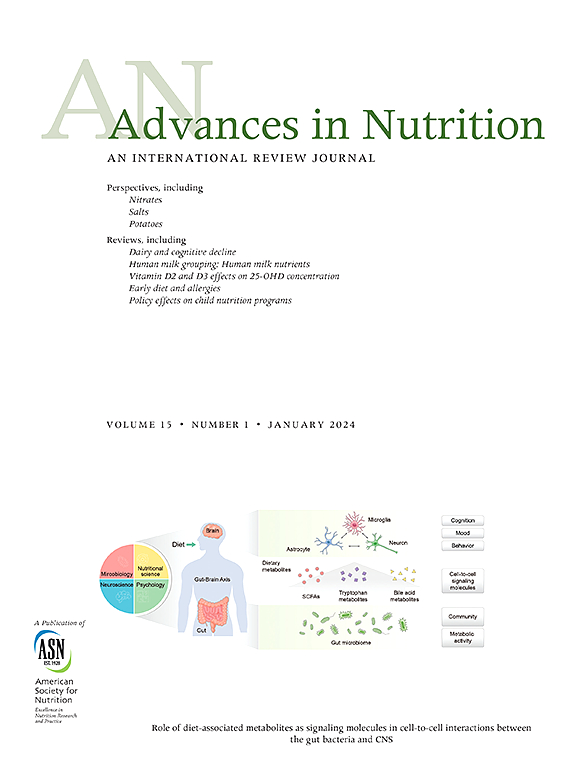Adolescent Dietary Intake and Breast Cancer in Adulthood: A Systematic Review and Meta-analysis
IF 9.2
1区 医学
Q1 NUTRITION & DIETETICS
引用次数: 0
Abstract
Adolescence represents a key opportunity for breast cancer prevention, as the rapid proliferation of breast tissue during puberty creates a critical window of vulnerability for the development of cancerous cells. With increasing research on adolescent dietary factors and breast cancer risk, we conducted a systematic review and meta-analysis to summarize the associations between adolescent diet and risk of breast cancer in adulthood, as well as benign breast disease (BBD) and high mammographic breast density, which are markers for breast cancer. We searched Web of Science, Ovid MEDLINE, Cochrane CENTRAL, and Embase for epidemiological studies assessing dietary intakes in adolescent girls (aged 10–18 y), published through 16 October, 2024, with no language or time restrictions. Study quality was assessed using the Newcastle-Ottawa Scale, and results were pooled using random-effects models. The review included 51 studies, mostly from the United States, with the majority relying on adult recall of adolescent diet, and only 20 studies were assessed as high quality. Higher adolescent intakes of fruits and vegetables [relative risk (RR): 0.90; 95% confidence interval (CI): 0.82, 0.99; n = 3 studies], soy (RR: 0.67; 95% CI: 0.55, 0.82; n = 3), dietary fiber (RR: 0.78; 95% CI: 0.67, 0.92; n = 3), and vegetable fat (RR: 0.76; 95% CI: 0.66, 0.88; n = 2) were associated with lower risks of breast cancer in adulthood. No significant associations were observed for meat and poultry, fish, processed meat/fish, eggs, dairy, milk, grains, alcohol, total fat, animal fat, and isoflavone. Additionally, greater consumption of dietary fiber (RR: 0.64; 95% CI: 0.50, 0.82; n = 2) and vitamin D (RR: 0.77; 95% CI: 0.62, 0.95; n = 2) during adolescence was associated with lower risks of BBD, whereas no dietary associations were observed for mammographic breast density. Our findings underscore the importance of both diet and timing in breast cancer prevention. Future well-designed prospective life course studies are needed to strengthen this evidence base.
This systematic review and meta-analysis was registered with PROSPERO (CRD42024532597).
青少年饮食摄入与成年期乳腺癌:一项系统综述和荟萃分析。
青春期是预防乳腺癌的关键时机,因为青春期乳房组织的快速增殖为癌细胞的发展创造了一个关键的脆弱性窗口。随着青少年饮食因素与乳腺癌风险的研究越来越多,我们进行了系统回顾和荟萃分析,总结青少年饮食与成年后乳腺癌风险的关系,以及乳腺癌的良性乳腺疾病(BBD)和高乳腺密度,这是乳腺癌的标志。我们检索了Web of Science, Ovid MEDLINE, Cochrane CENTRAL和Embase,以评估青春期女孩(10-18岁)饮食摄入量的流行病学研究,这些研究发表于2024年10月16日,没有语言或时间限制。使用纽卡斯尔-渥太华量表评估研究质量,并使用随机效应模型汇总结果。该综述包括51项研究,大部分来自美国,其中大多数依赖于成年人对青少年饮食的回忆,只有20项研究被评估为高质量。青少年摄入较多的水果和蔬菜(RR: 0.90; 95% CI: 0.82, 0.99; n=3项研究)、大豆(RR: 0.67; 95% CI: 0.55, 0.82; n=3)、膳食纤维(RR: 0.78; 95% CI: 0.67, 0.92; n=3)和植物脂肪(RR: 0.76; 95% CI: 0.66, 0.88; n=2)与成年后患乳腺癌的风险较低相关。肉类和家禽、鱼类、加工肉类/鱼类、蛋类、乳制品、牛奶、谷物、酒精、总脂肪、动物脂肪和异黄酮均未观察到显著相关性。此外,在青春期摄入更多的膳食纤维(RR: 0.64; 95% CI: 0.50, 0.82; n=2)和维生素D (RR: 0.77; 95% CI: 0.62, 0.95; n=2)与较低的BBD风险相关,而在乳房x光检查中没有观察到饮食与乳腺密度的关联。我们的发现强调了饮食和时间对乳腺癌预防的重要性。未来需要精心设计的前瞻性生命历程研究来加强这一证据基础。注册:该系统评价和荟萃分析在普洛斯彼罗注册(CRD42024532597)。意义声明:据我们所知,这是第一次全面回顾和量化青少年摄入各种饮食成分与成年后乳腺癌风险之间的关系。目前预防乳腺癌的饮食策略在很大程度上是由涉及成年人的研究提供的流行病学证据提供的。我们的发现为青春期饮食暴露与乳腺癌发展之间的潜在联系提供了初步的见解。我们还确定了青少年研究中的关键差距,强调需要继续开展针对形成时期的高质量研究,为未来的预防工作提供信息。
本文章由计算机程序翻译,如有差异,请以英文原文为准。
求助全文
约1分钟内获得全文
求助全文
来源期刊

Advances in Nutrition
医学-营养学
CiteScore
17.40
自引率
2.20%
发文量
117
审稿时长
56 days
期刊介绍:
Advances in Nutrition (AN/Adv Nutr) publishes focused reviews on pivotal findings and recent research across all domains relevant to nutritional scientists and biomedical researchers. This encompasses nutrition-related research spanning biochemical, molecular, and genetic studies using experimental animal models, domestic animals, and human subjects. The journal also emphasizes clinical nutrition, epidemiology and public health, and nutrition education. Review articles concentrate on recent progress rather than broad historical developments.
In addition to review articles, AN includes Perspectives, Letters to the Editor, and supplements. Supplement proposals require pre-approval by the editor before submission. The journal features reports and position papers from the American Society for Nutrition, summaries of major government and foundation reports, and Nutrient Information briefs providing crucial details about dietary requirements, food sources, deficiencies, and other essential nutrient information. All submissions with scientific content undergo peer review by the Editors or their designees prior to acceptance for publication.
 求助内容:
求助内容: 应助结果提醒方式:
应助结果提醒方式:


